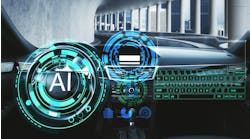As more auto manufacturers add connected car technology to their vehicles, a future where vehicles are in constant communication with one another and their surroundings could be near. Earlier in 2014, department of transportation secretary Anthony Foxx said collision avoidance technology would be the “next great advance in saving lives.”
To properly assess the technology, a government-sponsored pilot program run by the University of Michigan Transportation Research Institute in Ann Arbor was created more than two years ago. To date, nearly 3,000 vehicles driven by volunteers have been tested in real-world conditions with the hope of becoming a self-sustaining environment this year.
According to Debby Bezzina, assistant program manager, the study has yielded important insight into what the future of transportation could look like. Bezzina recently discussed the test environment and the insights gleaned from the pilot program.
What are the goals of the Safety Pilot program?
The objectives for Safety Pilot were to evaluate vehicle-to-vehicle and vehicle-to-infrastructure operationally in a real-world concentrated environment. The focus was on safety applications. We were gauging user acceptance, assessing the role of aftermarket devices, identifying any research gaps. Most importantly, we were generating data to support the safety benefits analysis that was conducted by the U.S. Department of Transportation (DOT).
The program began as a 30-month program but upon realizing the benefit of keeping the environment open, the U.S. DOT decided to keep our environment open. We still have vehicles deployed and we have only decommissioned some of them.
We equipped more than 2,800 vehicles, including passenger cars, buses, trucks, six motorcycles and one bicycle. We have 73 lane miles of roadway instrumented with 25 roadside equipment installations and we have also encouraged stakeholder utilization of the site.
We are now starting another three-year program to transition from a model deployment to a real-world early deployment. The goal at the end of the three years is to be a self-sustaining environment with no federal funding.
What’s the benefit of a test environment like this?
A lot of things work on paper but when you put them in the real world, you find all of those inefficiencies. For instance, the roadside equipment worked fine at the research center, but when we installed the equipment in Ann Arbor and attached them to a real city network, we found a lot of issues that needed to be resolved. I think that only by doing it in the real world can we fully test it.
Which devices are being tested?
We started with a basic vehicle awareness device. It’s transmitting the basic safety message 10 times per second. It does not generate any warning, it’s just giving your vehicle speed, direction, location and other data to other vehicles on the road.
One step up from that is the aftermarket devices. We have them for passenger vehicles and commercial trucks. For passenger vehicles, they have three warnings on them: emergency electronic brake light, forward collision warning and curve speed warning.
At the higher end were integrated safety devices, mainly for passenger vehicles. These are what’s going to give you the look and feel of a production system. They’re connected to the vehicle camera, they have different driver interfaces, as well as different applications that are being fielded, which are dependent on OEM choice. There were 64 passenger vehicles provided by eight OEMs.
For the aftermarket devices and the vehicle awareness devices, most of those vehicles were owned by the passenger. They were people that we had recruited from the community. They would come in, we would install the equipment on their vehicles and they would drive away and do their normal routine.
What other types of infrastructure has been installed?
We also had three retrofit devices installed in buses. We equipped 75 buses with vehicle awareness devices and an additional three devices were outfitted in a warning system. The infrastructure would give the buses a cautionary warning and an imminent warning.
We also had an infrastructure-based pedestrian detection application in front of the hospital, which is a very busy intersection. The infrastructure would give the buses a cautionary warning if someone had pressed the crosswalk button and it would give an imminent warning if they detected someone in the crosswalk.
Traffic lights can also be part of this network, showing how many seconds before a green light turns red, or predicting at what speed you need to travel to make continuous green lights.
Can you describe what it’s like to drive in that environment?
I have an aftermarket safety device installed in my personal vehicle. The warnings that I’m familiar with are electronic emergency brake light, forward collision, and curve speed warning. I didn’t receive many forward collision warnings but I did receive a few emergency brake light, which means that someone in front of me is panic braking. It gives you that extra alert that you need to be more prepared. Same thing with curve speed warning. With the infrastructure, it’s sending out a message with the curve location, characteristics of the curve and speed limit of the curve. I think that’s what I get the most because I’m speeding through a curve and it gives me a warning.
What have the big takeaways been?
U.S. DOT did the safety benefits analysis and issued a report showing that there is benefit from this technology. They call out in that report what they think the best benefit is and the percentage of crashes that can be avoided. For example, the report predicts that eight out of every 10 traffic accidents involving unimpaired drivers could be prevented. In addition, the report predicted that we could see 600,000 fewer crashes involving left turns or intersections, which could save more than 1,000 lives per year.
The bottom line is that the U.S. DOT has elected to proceed with rulemaking. They recently announced an advanced notice of proposed rulemaking, which would require vehicle-to-vehicle technologies on all new vehicles. They didn’t say what model year, but I imagine it will be in 2017, more than likely. A lot of the OEMs are really behind the technology and I think it will ramp up after that.
When it comes to collision repair, I do think that the future of repairs will be changing. However, it won’t happen overnight. As enhanced safety systems and automated vehicles are introduced, one would think that collisions would decrease. However, as more parts are added to vehicles for these features, more repairs will be needed. Although the collision business may decrease, I think it will be offset in part by increased maintenance and repairs.


